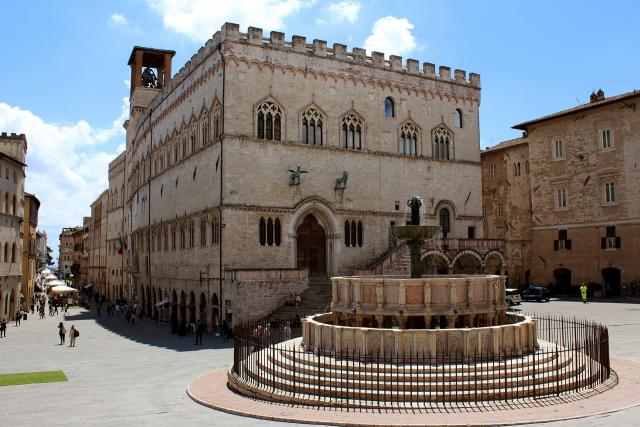Fontana Maggiore

Acting as the centrepiece for the new layout of the city, the Fontana Maggiore had not only a decorative function but also represented Perugia’s newfound prosperity. First conceived in 1275, the actual construction work was carried out between 1277 and 1278.
The immense technical challenges of the project were overcome by the master hydraulic engineer Boninsegna da Venezia who accomplished the outstanding technical feat of conveying water into the raised centre of the city from nearby Monte Pacciano via a forced aqueduct. Construction work for the project was supervised by the monk Fra Bevignate. The fountain itself, composed of two-tiered concentric marble basins, was created by the father and son team of sculptors, Nicola and Giovanni Pisano.
The twenty-five bas relief panels of the lower basin represent twelve monthly scenes from the annual cycle of labours with their corresponding signs of the zodiac; it also features the political emblems of the Guelph Lion and the Perugian Gryphon; personifications of the Liberal Arts and Philosophy; two eagles (signed by Giovanni Pisano both to establish his individual craftsmanship and in homage to the symbol of his namesake, Saint John the Evangelist ; stories from the Old Testament ; monitory folk tales and episodes from the story of Rome.
The upper basin features twenty-four statues paired around its twelve pillars in a celebration of Perugia’s own mythical figures (Matteo da Correggio and Ermanno da Sassoferrato, who were respectively podestà and capitano del popolo in 1278). Of particular note are the three figures facing the thoroughfare now known as Corso Vannuci: In the centre of the triad Augusta Perusia is seated on a throne between Domina Clusi (the figure holding a sheaf of wheat in allusion to the granaries of Chiusi) and Domina Laci (the figure holding a fish in reference to the waters of Lago Trasimeno), thereby representing an abundance of foodstuffs (and symbolising cornucopia).
The bronze cup topping the upper basin is surmounted by a group of bronze sculptures representing the three water bearers (These have now been replaced with fibreglass and the originals are on display in the nearby more protective environment of Galleria Nazionale dell’Umbria ). The cup bears an inscription, dated 1277, with the name of craftsman who cast it “Rubeus me fecit”. Bronze work, representing Perugia’s advanced mastery of plastic arts, also features in the decorative waterspouts shaped as wild animals.
Contacts:
Address: Piazza IV Novembre - 06123 Perugia PG